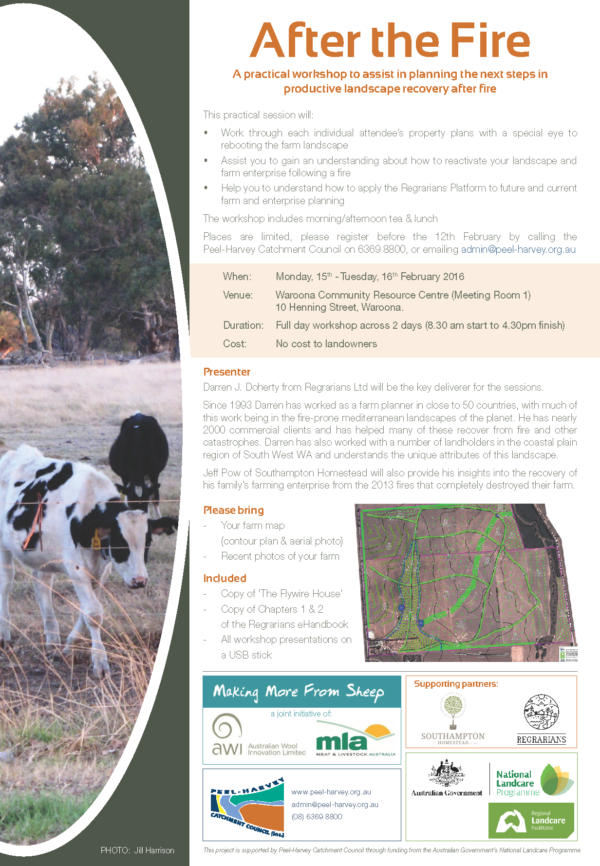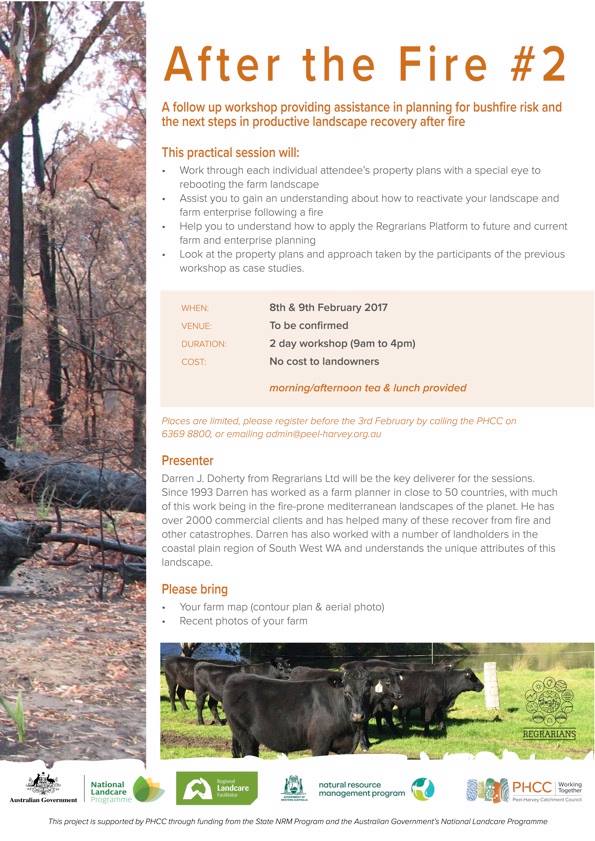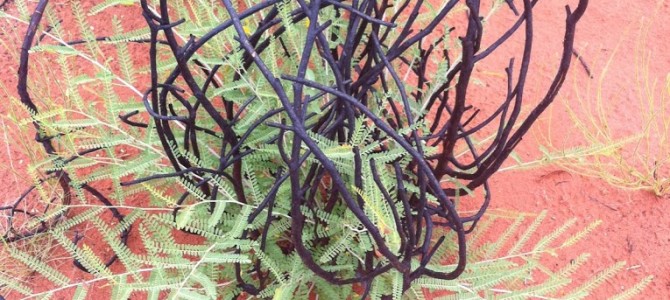We had a post by Adam Snow on our excellent Regenerative Agrarians Facebook Group that I thought would be great to turn into an ‘Off the Contour‘ post.
This is by no means a complete appraisal of what can or could be done #AfterTheFire.
What I have done though is apply the Regrarians Platform® to this question as it addresses the whole as best as I can and off the top of my head…
1•CLIMATE – Holistic decision making, anthropological context (culture, regulations, risk), and biospheric climate (weather patterns, temperature, precipitation, wind etc.):
- Fires are a horribly destructive events that effect people in very different ways. Its especially tough if there have been any stock/wildlife losses, crop losses, buildings, fences and other infrastructure lost but most of all precious possessions and loved ones. Coming back from that with any regenerative fervour is going to of course vary and some do really well and for others it triggers quite the opposite. So that’s the 1st thing!
- Its always a difficult scenario this one as there are a tonne of things that could be done and some of these have already been mentioned, especially the kind of work that Watershed Artisan‘s do and train people in. The main difficulty is in getting stuff done and having the resources to do it after something as hard as a fire.
- Get a copy of the following books:
- Talk to regulators and stakeholder groups about supporting & developing ‘Community Bushfire Strategies’ – this might start with holding an #AfterTheFire workshop in which effected landholders can work through their issues in a forum of facilitated participatory engagement (see #AfterTheFire workshop flyers in the Resources section below).
2•GEOGRAPHY – Landform/Keyline® geography/geometry, demography, geology, landscape capability, mapping (topographical, aerial, surveying):
- The location of fire (s) is going to be a blessing in some cases. It might have been hot enough to clear that bit of crappy bush and give you the legal opportunity to bring it into production where before you couldn’t.
- Some areas are going to be able to have different treatments applied according to their landscape element (ie. slope index, surface condition etc.) and one should analyse this first and run through a farm plan. Again this assumes you’re mentally, financially and physically ready to go!
- Victoria’s (Australia) ‘Bushfire Attack Level’ (BAL) rating system provides a leading framework for planning and planners alike to assess the risk to infrastructure of bushfire in different landscapes. In Victoria the BAL rating system is a mandatory municipal planning tool that all new dwelling projects must complete as part of the approval process. The BAL rating template is an excellent tool for assessing the risk that your property has and is easy to use.
3•WATER – Rehydration of the land for humans, their enterprises and the ecosystem (harvesting, storage, reticulation, effluent treatment); fires:
- Hopefully you’re header tanks weren’t poly and got burnt out! Or that your pipes were buried to a sufficient depth too and your troughs survived too…
- Chances are your hydrants would have been burnt unless they were ferrous in which case you should be OK. You’ll still need to get your systems back in order or take the opportunity to reconfigure, though again this takes time and cash
- Look at building high storages (tanks and dams/ponds) that will provide you with a gravity supply, not only for fire control, but also for stock and irrigation water the rest of the time.
- Riparian protection strategies are important to look at. Outside of arresting run-off wherever possible, silt-trap installations that are strategically placed to protect water storages and drainage lines is very important.
4•ACCESS – Access for people, vehicles (paths, tracks, roads) and utilities (electricity, telephony, services):
- I’d be assessing all access, especially if you’ve had any earthmoving equipment on the holding creating any control lines etc. as these might require some patching up…
- Again an opportunity to do some reconfiguration as part of the post-fire effort
5•ECOSYSTEMS – The overall agroecology (flora, fauna, fungi, algae, bacteria and other biota) including livestock, crops and forestry and the integration of these elements:
- Depending on the species and the intensity of the blaze you are either looking at a thinning project or a clearing project. Either way you are going to have some biomass coming your way. Again its a matter of having the resources (financial, human and mechanical) to make the most of the biomass ‘windfall’
- A lot of trees may now be dead and so look to clearing and grading these stems for future uses: e.g. firewood, poles, posts & sawlogs. A portable sawmill is a very useful machine after a fire and can bless you with a lot of timber for all manner of end uses.
- Contour brush piles are a really great strategy for using any burnt woody plant residues to help intercept runoff. These can be built by hand OR where machinery access is possible, using rotary hay rakes
- Ripping to keyline patterns any new plantings can be brought forward to reduce any runoff from the naked soils
6•BUILDINGS – The design, placement and construction of living spaces, agricultural buildings and portable infrastructure:
- Yards are perhaps the first thing to look at if you’re a livestock producer and these could take advantage of any suitable and burnt trees that are now ready for processing and use, though again labour and other resources come into play. An opportunity to reconfigure and replace and perhaps reposition as well
- Consider installing a roof/gutter sprinkler system — the Platypus Bushfire Sprinkler System is one such example
7•FENCING – The design, placement and construction of fences (perimeter, yards, laneways, subdivision, temporary, electric, living & shepherdry):
- Then comes the issue of fencing. If you weren’t in a bit of a spin, shock or otherwise after a conflaguration then you’d take this as an opportunity to establish an improved layout/material configuration and this of course takes time and lots of cash too — though the latter may well be covered by your insurance payout.
8•SOILS – Everything to do with soils – types, tests (geotechnic/agronomic) and the most cost effective treatments with which to regenerate soils:
- You’d love to put all of your stock at high density on these areas to get their hoof/manure/urine impact (AKA ‘Animal Impact’) but you’ve got to have the feed available to do this and if your feed has been destroyed then is tough. That said a lot of producers following a fire will be bringing in feed (as Michele Lally et. al. have done a bloody amazing job of doing in South Australia) and so this can be mobilised.
- Apart from the already mentioned interventions and animal impact one could also look to keyline/chisel plowing to immediately take out the surface capping that a fire will cause. You’ll also immediately reduce the bulk density and water-infiltration rates across any treated areas. Any other treatments such as embankments/swales etc are permanent and only act to harvest the mobile soil and not effect the rain drops on the now naked soils.
- Grasslands are adapted to fire and so yes you could take the opportunity to sow however as many of these fires occur in the middle of a very hot/dry season with mainly winter rainfall you could waste a lot of money on seed…Better off just getting the raindrops to infiltrate where they fall and wait until the temperatures drop and the existing seed bank jumps into action.
- If the fire was particularly hot then the seedbank may have been destroyed, in which case sowing any accessible areas with a mixture of cheap annual cover crop seed (oats, wheat, barley, triticale, vetch, clovers etc.) will be the best bet.
9•ECONOMY – Analysis, strategy and planning of the various capital flows and value chain:
- A quick replan of your Holistic Planned Grazing plan will have you assess how many stock you can carry with what feed you have available. Though stock are not going to be in the best condition, you may need the cash flow can come from selling stock.
- Assess your insurance coverage and strategise the use of any payments for the best effect. Shop around for insurance that is going to best suit your needs put the case that you’re looking to a range of improvements and fire protection infrastructure that will mitigate the risk significantly.
- Short term finance and welfare benefits are often available and should be used if available, especially the latter as you’ve paid your taxes for a reason and everyone else gets fed or clothed by you so its the least their taxes can do! Finance is something you could assess through looking at your financial plan and applying testing decisions as you would ordinarily
10•ENERGY – The generation and storage of energy (photosynthesis, fuel, electricity), machinery/implements, human & livestock nutrition:
- Photosynthesis is initially absent however summer-active perennial grasses (if any exist!) will spring back pretty quick as many are very well adapted to fire…This will give some green pick but try and not get on them too early so that you can kickstart some gains later on.
- Assess all energy supplies and generation equipment/storage for their operating capacity and condition
- Continue to observe/douse any stumps/posts and fallen timber so that future flare-ups are less likely to occur…
Could go on of course but this is a start…
I’ll leave it to others to contribute further!
RESOURCES
FILM, WEBINARS & PODCASTS
• #AfterTheFire – 2018 – Webinar – with Brittany Cole Bush, Art Ludwig, David Holmgren, Allan Savory & Darren J. Doherty
• Southampton Homestead & Farm – #AfterTheFire – 2015 – Short – with Michelle McManus, Jeff Pow & Lisa Heenan
• Understanding Fire – 2016 – Short – with Victor Steffensen et.al. – https://youtu.be/hqkjl1__igY
• #FireHomeSchool: Aboriginal Fire Management in Australia– 2020 – Webinar – Pau Costa Foundation – with Victor Steffensen –
• 2018 National Indigenous Fire Workshop – 2018 – Workshop – Bundanon Trust, NSW
• RIGHT COUNTRY – RIGHT FIRE: Podcast Series – Firesticks Alliance
• Facing Fire: Building Resiliency to Wildfire – 2019 – Short – by Javan K. Bernakevitch featuring Stephen J. Pyne, David Holmgren, Dan Halsey, P.A. Yeomans and others
BOOKS & ARTICLES
• The Flywire House: A case study in design against bushfire – 1991 – Book – David Holmgren
• The Complete Bushfire Safety Book – 2000 – Book – Joan Webster
• Essential Bushfire Safety Tips 3rd Ed. – 2012 – Book – Joan Webster
• Fire Country: How Indigenous Fire Management Could Help Save Australia – 2020 – Book – Victor Steffensen
• Looking After Country with Fire: Aboriginal Burning Knowledge with Uncle Kuu – 2022 – Book (Childrens) – Victor Steffensen, Sandra Steffensen (Illustrator)
• Burning bush: a fire history of Australia – 1991 – Book – Stephen J. Pyne
• The Regrarians Handbook – 2015:present – Book – Darren J. Doherty, Andrew Jeeves & Georgi Pavlov
• Reintroducing Traditional Land Management Practices – 2012 – Booklet – Rodney Mason et.al.
• Bushfire Resilient Communities and Landscapes – 2009 – Discussion Paper – David Holmgren
• Reflections on fire – February 2019 – Article – David Holmgren
• Before The Fire Resources – Regrarians.org
• The Challenge of Landscape – The Development & Practice of Keyline – 1958 – Book – P.A. Yeomans
• The City Forest – The Keyline Plan for the Human Environment Revolution, – 1971 – Book – P.A. Yeomans
• Possible New Approach to Bushfire – 2015 – Article – Graeme Hand, (HandfortheLand)
ORGANISATIONS
• Mulong – Victor Steffensen
• Firesticks Alliance
• Bushfire & Natural Hazards CRC



